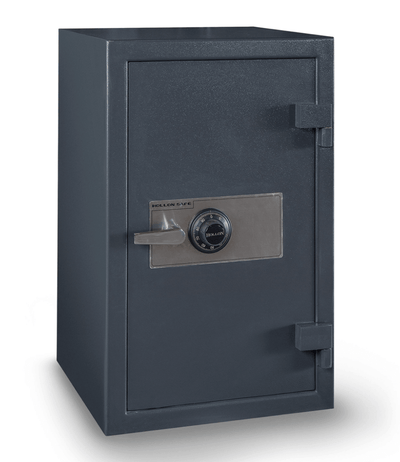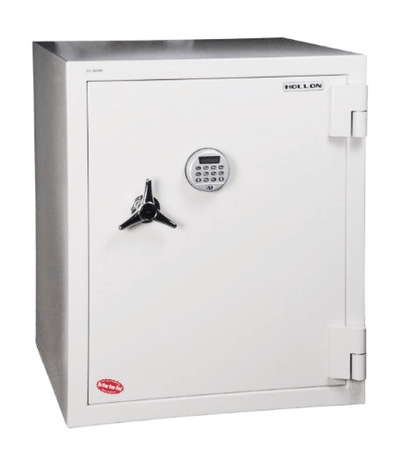Owning valuables comes with the responsibility of keeping them safe. With all kinds of unforeseen incidents happening around the world, security and protection are things that should never be taken for granted. One doesn’t need to be a full-on doomsday prepper to understand how important being ready for anything is. Anyone who possesses anything of value, whether it is financial or emotional, should secure it under lock and key inside a safe.
What is a Safe?
The invention of the modern safe dates way back in the 1800s. Ever since then, safes have been mainly used to keep items protected against theft and fire. More often than not, these items include cash, jewelry, guns, documents, and thumb drives or other data devices. Safes usually have a cube or cylindrical shape and hollow interiors in which the items can be stored. The body and door of most safes are made with durable materials, such as steel or plastic.
Nowadays, safes are designed with several features that can resist attacks from power tools, withstand fire and water, and so on. They come with locked doors that can only be opened with a key, a specific combination, or the user’s fingerprint. Some safes, particularly bank safes, feature depository slots through which banknotes and envelopes can be dropped.
Parts of a Safe
Of course, the most important question is: how can safes protect their contents from damage or theft? For starters, they are comprised of various parts, each of which is designed for a specific purpose.
1. Body
The main frame of the safe, or what mostly comprises the exterior part of a safe, is called the body. The bodies of most safes are made with metal, usually steel, and they are constructed to withstand bullets, explosives, drill attacks, fire, and virtually anything. Some bodies of safes also come with pre-drilled bolt holes so that they’ll be completely ready for wall or floor installation.
2. Door
Safe doors are typically as thick as the bodies, and they’re also constructed with the same materials that make up the rest of the safe. These doors swing outward or upward on their thick internal hinges. The doors of some safes feature an airtight or watertight construction, which makes the safes fireproof and prevents water from seeping in.
3. Lock
What makes a safe different from any ordinary steel box is its locking mechanism. Basically, locking mechanisms come in various types, but the most common ones are key locks, dials or combination locks, electronic keypads, and biometric scans. Some locks also come with hard plates that can resist drills and ballistics for extra security. Poorly-built locking mechanisms are usually susceptible to tampering, which is why the locking mechanism is the most vital component to examine when choosing a safe.
4. Relocker
Apart from locking mechanisms, some safes come with relocking devices. These devices are pretty useful in the event of a burglary attempt. When a safe detects an attempted breach, its relocker triggers an internal bolt that locks the safe permanently. Only an expert safe technician can open a safe after its relocking device has been activated.
5. Shelving
To keep items organized while they’re stored, the interiors of some safes have built-in shelves. There are shelves that are lined with soft fabric to protect their contents against scratches. Some shelves are fixed in the safe, while others are removable or adjustable for easy organization. Other types of safes, particularly gun vaults, have pocket organizers on the inside of their doors. There are also others with internal locking drawers for additional secure storage.
UL Certification

Even when manufacturers and salespeople go on and on about the features of their safes, it’s best to know whether their products are certified by the Underwriters Laboratories (UL) or not. The UL is a nationally recognized testing laboratory that establishes standards for various products, including safes. Safes with UL ratings offer, at the very least, the bare minimum requirements that allow safes to function as they are designed to. Moreover, the UL conducts fire and burglary tests on safes and provides them with the appropriate classifications or ratings. The UL rating of a safe thus proves if it is indeed burglarproof and/or fireproof.
1. Fire Resistance
Safes with fire ratings are classified according to the fire temperature and the duration of their exposure to fire. For instance, a safe rated UL Class 350 2-Hour has endured two hours of exposure to an outside temperature of 1,700 degrees Fahrenheit before reaching an internal temperature of 350 degrees Fahrenheit.
2. Burglary Resistance
Since theft is the number one reason for using safes, they are also subjected to the UL’s burglary test. Safes that have undergone this kind of test have a certain TL rating. This rating corresponds to the length of time that the safe has withstood a sophisticated attack by a well-equipped and skilled burglar.
A TL-30 rating, for instance, means that a safe has endured attacks for about 30 minutes from mechanical and electrical tools. TL ratings range from TL-15 to TL-40, and the higher the rating, the more secure a safe is. Some safes have TL ratings with X6 at the end, which indicates that the safe has withstood an attack on all six sides.
Apart from TL ratings, there are also TR or torch resistant and TRTL or torch and tool resistant ratings. As their names suggest, these ratings signify that the safes can resist attacks from torches or from both torches and power tools.
3. Dust, Water, and Impact Resistance
In addition to the UL fire and burglary ratings, some manufacturers of safes have subjected their products to standardized tests by the Japanese Industrial Standards (JIS), the Korea Industrial Standards (KIS), or the Scientific and Technical Center for Building (CSTB). There are safes that have passed a 30-foot impact test, which can be useful in fire emergencies wherein safes have to be dropped from a two-story building. There are also safes that feature an airtight construction to prevent water and dust from coming in and damaging their contents.
Basic Kinds of Safes
Because of the various needs and preferences of owners, safes come in different types and designs based on the locations where they will be placed and the items that will be stored.
1. Wall Safes
Safes displayed in full view won’t be as secure as those installed within walls. Those who own wall safes need to create a recess in the wall in which the safe can be hidden from view. Installing safes in walls can make them inconspicuous and keep them away from prying eyes. For an extra level of security, paintings or posters can also be hung on the wall to hide wall safes completely.
2. Floor Safes
Similar to wall safes, safes placed within floors also provide their contents with additional security. The main difference between wall safes and floor safes is that the latter will be harder to remove. Most floor safes are also designed to be concreted into the floor so that it will be entirely impossible for burglars to pry them off the floor. Users can hide floor safes under rugs or carpets to keep them out of sight.
3. Gun Safes
Gun safes and vaults come in a variety of sizes, depending on the size of the owner’s firearm collection. There are gun safes that are small enough to place under a bed or in a narrow closet, which allows users to quickly access their weapons in emergencies. There are also gun vaults that are as large as cabinets for storage of rifles and other hunting weapons.
4. Jewelry Safe
Usually, jewelry safes are as beautifully-crafted as the jewelry they store. Their interiors are made of natural wood and lined with a smooth fabric, such as velvet, on which pieces of jewelry can be safely nestled. Their soft linings also protect jewelry against scratches or wear. Some of these safes feature drawers or shelves so that rings, watches, necklaces, earrings, and others can be easily organized. Regardless of the elegant appearance of jewelry safes, they are built to resist burglary attacks and fire as well.
5. Data Safes
Every business has sensitive documents and files that are not meant for all eyes to see. Data safes can provide these documents with their much-needed security. Because documents are made up of flimsy, flammable sheets of paper, these safes usually offer high resistance to fire. Apart from documents, these safes are designed to store thumb drives, CDs, tapes, and other types of media.
6. Depository Safes
Mostly used in banks, depository safes allow employees to drop envelopes or cash through a slot or a depository door, which is equipped with an anti-fish baffle system. This baffle system prevents people from reaching through the safe’s depository slot or door and fishing out the safe’s contents. Some depository safes also come with chutes or hatches. They are designed to be placed in a separate secure room, while their chutes have to be installed through the wall with the chutes’ openings facing another room.
7. Hotel Safes
Hotel safes are normally placed in every guest room of hotels, inns, and other hospitality establishments. Since hotel rooms can be accessed by the hotel staff, guests can feel more at ease when they temporarily store their valuables inside these safes.
Why Should You Own a Safe?
A safe is one of the best things that anyone can invest in. Because of their construction, safes can keep their contents secure and well-protected against so many things.
1. Protection Against Theft
The most common reason why people invest in safes is to keep their precious possessions safe from break-ins and burglary. It’s no question that thieves have existed since the dawn of civilization, and thefts can happen to anyone. Losing items to thieves can be painful financially and emotionally. However, sensitive documents falling into the wrong hands can also endanger one’s privacy and identity and can even give way to acts of fraud. Without a doubt, the best protection that one can provide their things is a safe.
2. Protection Against Disasters
Apart from burglary incidents, natural and human-made disasters can surely damage items, especially cash and valuable documents. This is why a lot of safes offer fire resistance. They can protect their contents against fire or high temperature levels. Some even feature a watertight construction, which can come in handy when firefighters put out a raging fire by blasting water from hoses. Water-resistant safes can also be advantageous in the event of floods. Whatever disaster comes your way, there are all types of safes that can protect valuables against damage.

3. Prevent Accidental Firing
Not only can safes protect contents against damage, but they can also protect every person in the house. In particular, gun safes can keep firearms and other weapons away from anyone’s reach. Being a responsible gun owner entails securing guns from unauthorized people, especially children. Storing a gun in a safe is a way better alternative than having it lying around. Doing so can prevent people from accidentally firing the gun and hurting others and make a home a safer environment to live in.
4. Quick Access to Valuables
Be that as it may, safes can store items while keeping them readily accessible. Some safes are designed like strongboxes that can be stowed away under the bed or in the closet. In emergency situations, having a safe eliminates the need to look for important items around the house. Storing all valuables in one secure container allows users to get them all quickly in times of crisis.
5. Cost-Efficient
Finally, owning a safe is a cost-effective means of providing expensive valuables with protection. There’s no need to hire someone to guard the items or to have a separate room or closet built for secure storage. Investing in a safe can give anyone peace of mind for life.
Is it worth owning a safe?
Having a safe is considered as a preventative measure. Although not everyone experiences thefts or fire emergencies in their lives, a safe can protect valuables against getting stolen or damaged when the need arises. Once valuables are stolen or consumed by fire, there’s really no way you can get them back.
With a safe, on the other hand, you can make sure that your precious belongings are well-protected against unforeseen incidents. Seasoned burglars will have a hard time breaking into high-quality safes and stealing their contents. In case of fire emergencies, valuables will remain intact inside a fire-resistant safe. Given these situations, investing in a safe is a small price to pay for protecting your valuables.
There’s no reason not to own a safe, especially when you have a lot of valuable belongings that you cannot afford to lose. Here on Engineer Warehouse, there are a variety of safes from which you can choose to store valuables. There are jewelry safes and gun safes for your home, and there are also depository safes, data safes, hotel safes, and many others for your business. Most of these safes are UL certified, which ensures a high standard of security for your valuables.























